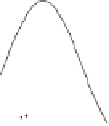Environmental Engineering Reference
In-Depth Information
1400
Yellow Perch
Logperch
Black Crappies
Pumpkinseeds and Bluegills
1200
1000
800
600
400
200
0
5/7/69
5/17/69 5/27/69
6/6/69
6/16/69 6/26/69
7/6/69
7/16/69 7/26/69
8/5/69
8/15/69
FIGURE 20.6
Numbers of larval fish in a small eutrophic lake during a summer succes-
sional sequence (redrawn from Amundrud
et al.,
1974).
phytes dominated in later years, and macrophyte community diversity in-
creased and stabilized after two decades (Kuflikowksi, 1986). Riverine fish
and invertebrate species were replaced by species more common in lakes
within the first few years (Starmach, 1986; Krzyzanek, 1986).
An unusual but interesting case of succession occurred when Mt. St.
Helens in Washington State (Fig. 20.1) erupted and drastically altered Spirit
Lake (Larson, 1993). The lake was an oligotrophic mountain lake before
eruption. The eruption superheated the lake's waters, killed most of the an-
imals and plants, and filled the lake basin with volcanic ash and tree trunks.
Soon after the eruption, the water went completely anoxic, leading to a
community dominated by heterotrophic and chemoautotrophic bacteria, a
few protozoa, and rotifers. By the next spring, O
2
returned to the epil-
imnion of the lake, and a moderately diverse phytoplankton community de-
veloped. Five years later, a diverse phytoplankton assemblage had colonized
the lake as well as at least four zooplankton species. Eight years after erup-
tion, macrophytes [milfoil,
(Myriophyllum)
and stonewort
(Chara)
had be-
come established, as had snails and other macroinvertebrates.
Seasonal wetlands may experience a strong successional sequence. For
example, in the Pantanal wetlands in Brazil, a seasonal wet-dry cycle leads
to large and predictable changes in the aquatic communities (Heckman,
1994). During the wet season, considerable flow can occur in the main
channels, but during the dry season these same channels become lentic.
Macrophyte populations develop during the dry seasons and are flushed
out during the wet seasons. During the dry periods, the large number of
fish trapped in drying ponds attracts many waterbirds and caimans (a croc-
odilian) that consume them. These isolated ponds become hypereutrophic
from the nutrients released from the dying fish and excretion from the











































































































Search WWH ::

Custom Search